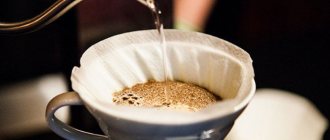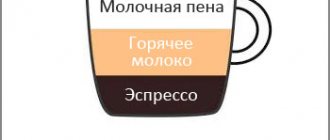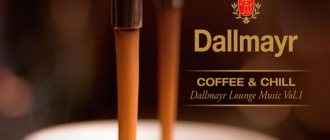5
(12)
As you know, Italy consists of 20 regions, which were united into one only in 1861, that is, some 150 years ago. “Regionality” and “parochialism” make up the entire charm of the Apennine Peninsula. Each region is unique and proud of its special dish or product, and if this product is typical for several regions, then the competition here is simply serious!
What is Italy most often associated with, after pasta and pizza? Of course, with coffee. Let's find out where to look for the best coffee in Italy, how to order coffee in a bar or coffee shop, and how coffee in Naples differs from coffee in Turin.
History of Italian coffee
Coffee does not grow in Italy, there are no favorable conditions for this shrub, but the process of conquering Europe with an invigorating drink began precisely from this country, or more precisely, from its independent republic - Venice. Italian coffee beans - this product was one of the goods that rich Venetians traded, buying it from the Turks and reselling it to Europeans. But this happened much later.
The first coffee beans were brought to Milan from Africa as a material for study in 1500, and mass purchases of coffee began 125 years later, the supplier was Yemen. In Venice, for the first time in European regions, coffee shops began to appear, the number of which reached 2 hundred over several decades. Here you could not only try a tasty and aromatic drink, but also socialize as if at a social event. Intellectual youth, the elite, famous artists and politicians liked to gather in coffee houses.
Italians are the developers of several roasting technologies, the strongest of which is called dark or Italian. They know how to organically blend varieties of coffee beans, carefully select raw materials, and amazingly sense the finest facets of taste and aroma, which is why they are considered the best in the field of drink production and preparation.
Origin
Probably no one will be able to say for sure when and by whom coffee was discovered. One version of the origin of coffee takes us back to 900 BC.
It was then, according to legend, that one of the Ethiopian shepherds noticed the very active behavior of goats after eating red berries on one of the trees. After tasting these berries, the shepherd felt his body filling with strength and energy.
It was in this area of Ethiopia, called Kaffa, that the coffee tree and coffee, the drink obtained from it, found their name.
Since then, they have tried to process the fruits of the coffee tree in a variety of ways. The grains were dried, boiled, crushed, and made into a tincture. And all this for the sake of the tonic effect of coffee beans. Over time, the Ethiopian lands were occupied by the Arabs, and the habit of consuming the tonic product took root among the new residents. They ground raw grains, mixed them with fat and made balls that were very convenient to take on the road. Raw coffee beans are small nuts that contain caffeine. Therefore, the resulting ground product could both feed and invigorate travelers during long journeys.
It wasn't until many centuries later that experiments with coffee beans came down to initial purification, followed by roasting and grinding to further brew the resulting powder.
The resulting aromatic drink could not compare to the initial attempts to consume coffee beans. Historians say that coffee seeds were first roasted in Yemen in the 11th century AD. In addition, the Arabs began to add cinnamon, ginger and other spices to the coffee drink when brewing.
By the mid-15th century, coffee reached Turkey. The easterners liked it so much that the church ministers had to curse the coffee with the name of the prophet. After all, they saw that believers began to spend much more time in coffee shops than in prayer. However, over time, the church's dislike of coffee faded.
Along with the widespread use of coffee, the art of preparing this drink also appeared. Places where coffee was prepared in public began to appear everywhere. Coffee shops became places for meetings, and coffee served as a reason for pleasant friendly communication. The image of coffee shops gradually moved to Europe over time. And their inner world is reflected in modern cafes.
Coffee came to us from Turkey. However, the bitter drink could not take root in Rus' in the Middle Ages. However, in the 18th century, Peter I began to insist on drinking coffee, believing that it promoted mental agility. And after 1812, drinking coffee in Russia began to be considered a sign of good manners.
Types of Italian coffee and coffee drinks
Real Italian coffee is prepared in several varieties, which differ in the degree of strength, as well as individual components. When traveling through the cities of Italy, you should definitely try:
- caffè - regular espresso served in tiny cups;
- cappuccino – consists of 1/3 espresso, 1/3 milk and 1/3 delicate foam;
- macchiato - espresso, to which a drop of milk is added to obtain a more delicate taste;
- caffè lungo – “long” espresso with double the amount of water;
- espresso romano – strong espresso with lemon juice, served in a heated cup;
- caffè latte – coffee with milk in a 1:1 ratio;
- latte macchiato – prepared from steamed hot milk with the addition of a small portion of espresso;
- Ristretto – very strong coffee with a small amount of water, literally “just a sip.”
The word latte means "milk" in Italian. To avoid getting a regular glass of milk at the bar instead of a cup of the desired coffee drink, you need to specify caffè latte or latte macchiato when ordering.
Popular Italian brands
A large number of famous coffee brands are concentrated in the country. Therefore, tourists often ask whether coffee grows in Italy. Despite the fact that the country occupies a leading position in its production, the local climate is not suitable for cultivation.
Italian manufacturers have developed unique technologies for roasting coffee beans, which are rightfully considered the best in the world. They have perfectly mastered the blending technique, skillfully combining grains of different varieties, amazingly achieving a drink that is balanced in taste and aroma.
Culture of preparation and consumption
In Italy they love coffee so much and drink it so much that they have come up with many ways to prepare it. Italians make coffee for breakfast, together with or instead of smoke breaks and, of course, after meals along with dessert.
The classic type of coffee, also called “normale” (from “normale” - ordinary), is considered espresso. What is served in Russia and the countries of the former Soviet Union as espresso is most often very different from its Italian counterpart.
Italian espresso is a velvety dense foam with a golden tint that covers the entire surface of the coffee in the cup, a soft aroma that fills the entire room and makes you forget about everything. The perfect, balanced, pronounced taste of real Italian espresso cannot be described in words.
According to the rules of coffee etiquette, espresso is served in a porcelain cup with thick walls shaped like a truncated ellipse. The standard volume of such a cup is 75 ml, but the contents, depending on the type of coffee, should take from 25 to 50 ml. This serving maximizes the taste and aroma of coffee. In bars, coffee is brewed by a special specialist called a barista.
What coffee should you try in Italy?
You will always find these types of Italian coffee in the best coffee shops in Rome.
Caffè di orzo (caffe 'di orzo) - this type of “coffee” is prepared on the basis of barley and is much easier to digest by the body;
Caffè al ginseng (jinseng) is another alternative to classic coffee. Ginseng is prepared with ginseng root, cream and sugar;
During the hot season, try caffè shakerato (“caffe shakerato”) - this is coffee mixed with pieces of ice and sugar. Or another similar treat: granita di caffè (granita di caffe') is ice crushed into fine crumbs, mixed with syrup based on coffee and sugar. This dessert will help you not only refresh yourself, but also cheer you up!
By the way! If you are lactose intolerant or allergic, you can request that your coffee drink be prepared using basaltose-free milks (lactose-free, soy, coconut, etc.).
Segafredo
The classic Segafredo coffee has a composition of Arabica and Robusta that is close to optimal, which makes us think of this coffee as a remarkable product.
Brewed coffee has a soft and rather rich aroma, with sourness and a pleasant bitter aftertaste. A fragrance that could be called “no frills”, but with a positive connotation. The taste of coffee is frank and simple, with some nuances.
This coffee will be the right choice if you want to save money but get a quality product.
Rating: 7
Price per kilo: 7.18 euros
How to drink coffee the Italian way
There are several unwritten rules regarding coffee consumption that Italians try to adhere to in everyday life:
- Drink coffee drinks with added milk only before noon. Many people have heard about this “rule,” but not everyone knows what exactly it involves. In fact, reducing milk consumption in the afternoon is explained by the fact that in the evening hours it is poorly absorbed by the body and slows down metabolism. But a cup of strong coffee, on the contrary, helps stimulate it, so in Italy it is customary to drink espresso (caffè) after a meal in order to digest what you have eaten;
- In Italy, there is no fashion for prolonged drinking of coffee drinks, to which we are so accustomed. Here it looks more like: dropped into a bar, drank coffee, exchanged a few words with the barista and left;
- Drink coffee at the bar. This is done in order not to overpay for table service, which is automatically included in the bill if you decide to sit down and slowly drink coffee (+ 1-3 euros);
- While you are in Italy, forget about the popular “coffee-Americano”: according to the Italians, it’s just (we quote): “. poor and unfortunate caffè espresso, impossibly diluted with water to the point. incomprehensible slurry!
And one more thing: drinking cappuccino and any other coffee drinks during lunch or dinner (at the same time as the main courses) is considered truly wild, see the rules of conduct in an Italian restaurant
Coffee with alcohol:
✅ Caffè corretto literally translates as “correct coffee.” This means that a couple of drops of strong alcohol – sambuca or grappa – have been added to the espresso.
✅ Ammazzacaffè , or “killer coffee,” is a glass of alcohol (usually sambuca, grappa or bitter amaro liqueur) drunk after espresso and a hearty Italian meal.
Other related articles:
- The history of pizza: how the edible symbol of Italy appeared
- Roman pizza VS Neapolitan. Which one tastes better?
- How to choose a pizzeria in Italy that serves delicious pizza
- 7 Famous Italian Dishes You Should Know More About
- Aperitif and digestif: what is the difference and how do Italians drink?
Quests in Italy
Excursions in Italy
Master classes with Italians
Transfers in Italy
A minute of Italian: how to order coffee at a bar
Want to order coffee at an Italian bar but don't speak the local language? No problem! You only need to say a couple of simple phrases:
To order coffee (in this case, espresso), simply say: “Un caffè, per favore”;
If you want to order more than one drink at a time, replace UN with due (two), tre (three), quattro (four), etc.;
If you want to order coffee with lactose-free / soy milk, just say the following: “(Name of the desired coffee drink) + con (con / “with”) + latte di soia (latte di soya / “with soy milk”) / con latte senza lattosio (con latte senza lattosio / “with lactose-free milk”)”;
To ask for the bill, say: “Posso pagare?” " (posso pagare / “Can I pay?”), or: “Il conto, per favore” (il conto, per favore / “Bill, please”) - and then list at the checkout everything you ordered ;
By the way! In some bars, it is customary to first pay at the cash register and then take your order: in this case, dictate everything you want to take, pay, and then go to the bar with the receipt;
At the end say: “Grazie” (grace, that is, “Thank you”), and then add: “Buona giornata!” (bu ò na djornàta / “Have a nice day!”). Politeness is pleasant for everyone, and in Italy it is an integral part of the local mentality!
Coffee as a gift from Italy
Do you want to bring an original gift from Italy? Coffee has long been on the list of popular souvenirs from Italy . We recommend buying several bags of Italian ground coffee, for example, Trombetta and Illy brands and, most importantly, the famous Italian geyser coffee maker (Italian “moka, caffettiera”) of the Bialetti brand: this is where you can prepare real delicious Italian coffee at home!
Pour water into the lower compartment to the level of the “screw”, put the funnel-shaped container in place and carefully pour coffee into it to the very edge;
Connect the top to the bottom and twist the mocha tightly. Place on low heat. During the process of heating and boiling, water from the lower part of the coffee maker will gradually rise through the “geyser” system through the funnel with ground coffee, eventually emerging as a finished coffee drink into its upper part;
Never clean the moka with detergents after use: just rinse it with water. In addition, the taste of the finished drink will become more rich and aromatic with each subsequent use of the coffee maker. Therefore, the first 3 cups of coffee in a new moka are usually brewed “to throw away”, so that next time you get a truly tasty and invigorating drink!
Coffee in Italy is a national drink, so it is made well almost everywhere; even in the most inexpensive Roman cafe you can enjoy the aroma and delicate velvety taste of the best coffee.
Pellini
The good old coffee tin pack gives off such a strong aroma that expectations skyrocket.
However, this is not a dream cup of coffee, and the blended drink has strong hints of dark chocolate flavor in the mouth, which softens its bitterness. However, the aftertaste quickly disappears.
Thus, they hoped in vain. Keep in mind, this is a good and rich coffee, it's just a shame that the sensation quickly evaporates.
Rating: 7.2.
Price: 15.96 euros per kg.
Italian traditions: what tourists need to know
Italians drink coffee many times a day, but in small portions. They often run into the bar for a cup of espresso. Interestingly, the time of day directly determines what kind of coffee they drink in Italy.
For example, coffee with milk is only served until 11 am. This rule is strictly observed. According to Italians, milk after eating causes indigestion. A tourist who orders a cappuccino or latte in the second half of the day will have it prepared, but will be surprised at the strange choice.
Also, in Italy it is not customary to sit in a cafe over a cup of coffee. They drink at the bar without staying long. Seats at a table can be 2 times more expensive. And Italians don’t drink espresso that’s too hot. It is served at a certain temperature so as not to burn yourself.
The word espresso is not pronounced in Italy; it is simply replaced by caffe. Espresso is the basis of all Italian coffee drinks. Everything else is just its variations.
TOP 5 best coffee shops in Rome
To visit Rome and not try real Italian coffee means to learn nothing about Italy. Italians spend quite a lot of time in coffee shops, which are called bars here. The best coffee in Rome can be had in places like these.
Antico Caffè Greco (Via dei Condotti, 86)
An excellent choice for those who want to touch Italian history. Just think, famous poets, philosophers, and composers gathered in this cafe for intellectual conversations! Hans Christian Andersen, Mark Twain, and Wilhelm Richard Wagner visited him when they were in Rome.
The atmosphere of Antico Caffè Greco is a world of Old World luxury with gilded decorations, marble tables, works of art on the walls. Prices here are quite high. A cup of espresso drunk at a table in this cafe will cost 7 €. Not cheap, but the pleasure is worth it.
Sant Eustachio Il Caffe (Piazza di San Eustachio, 82)
The cafe is located in the very center of Rome, not far from the Pantheon. Coffee is brewed here according to a special recipe, which is kept in the strictest confidence. Regular espresso at Sant Eustachio Il Caffe has a completely unimaginable aroma, a special thick foam and a dark chocolate aftertaste. Be sure to also try Caffè d'Elite – 3.9 € and the signature Gran Caffè – 5.4 €.
The cafe has a store where you can buy beans or ground coffee to treat yourself to the unique taste of the drink at home. A 250 g can of one of the branded coffee beans costs 7.9 €, in soft packaging – 6.3 €.
D'Angelo – Gastronomia Caffe (Venti Settembre, 25)
Best place in Rome for an inexpensive Italian breakfast. Amazingly delicious fresh pastries and cappuccino costing only 1.2 € will not leave anyone indifferent. A typical Italian atmosphere and a smiling bartender will help you feel the real spirit of Italy.
Tazza D'Oro (Via Marche, 52)
Tazza D'Oro is the name of a coffee shop in Italy, which is associated with a black beauty who sows coffee beans around the world. This is the logo that greets visitors at the entrance to the cafe. There is an exceptionally delicious latte - 1.1 €, cappuccino - 2.2 € and espresso for 0.9 €.
You can also buy branded coffee with the cafe’s logo to take with you: a 250 g package costs 10.87 €, 1 kg – 43.45 €, a 250 g can – 13.17 €.
Sciascia Caffe (Via Fabio Massimo, 80/A)
This place is recommended by locals. There are few tourists here, a quiet, calm environment. The delicate smell of freshly baked croissants and the invigorating aroma of coffee makes you feel dizzy already on the threshold of the cafe. You will be served a cappuccino, masterfully decorated with a design of foam, at a price of 1.3 € per cup. I want to come back here again and again!
Italy and coffee are inseparable concepts; people here truly know how to infect people with their love for this drink. And once you try real Italian coffee, you will certainly become a fan.
For real coffee lovers
True coffee lovers should visit Italy at least once in their lives. We advise you not to miss the chance and take a thematic excursion. We have selected the best options for “coffee” excursions in Italy in Russian.
Coffee Rome
An individual walk around the Italian capital in the company of a professional barista. The best espresso in Rome, the most iconic coffee shops in the city, everything about the culture of drinking the drink. Sounds tempting, doesn't it? Along the way, the guide will show you the sights and tell you what guidebooks don’t write about. Read more details and reviews from tourists here.
Delicious Florence
Tasting the best Tuscan delicacies on an excursion in Florence with a Russian guide. Snacks, desserts, street food, traditional dinner, wine. But it all starts, of course, with coffee - you’re in Italy. The most delicious and “correct” cappuccino in the city, the best types and varieties of the drink and local traditions. You'll like it! More details at this link.
Milano with espresso flavor
On an excursion in Milan you will understand the coffee traditions, habits and rituals of Italians. You will find out the difference between a ristretto and a corretto, why you should not order cappuccino after lunch, and try interesting drinks. You will also visit the best coffee shops: famous and secret ones. Detailed information about the tour and reviews here.
Tastings in Naples
Only in Naples can you try the “correct” Caffè Napoli. The guide will tell you everything about the legendary drink. He will also show you secret coffee shops and the best pastry shops in the city. You will visit colorful shops and eateries, try cheeses and sausages, and visit a legendary pizzeria. Not an excursion - a fairy tale! Read more details and rave reviews from tourists at this link.
Before traveling to Italy, check out our post on shopping in Rome and provincial cities. Be sure to try the local coffee and bring a couple of packages of good grain or ground product as a gift to your loved ones.
>>> Useful services for travelers <<











